VAUXHALL CORSA 2014.5 Owner's Manual
Manufacturer: VAUXHALL, Model Year: 2014.5, Model line: CORSA, Model: VAUXHALL CORSA 2014.5Pages: 231, PDF Size: 6.8 MB
Page 171 of 231
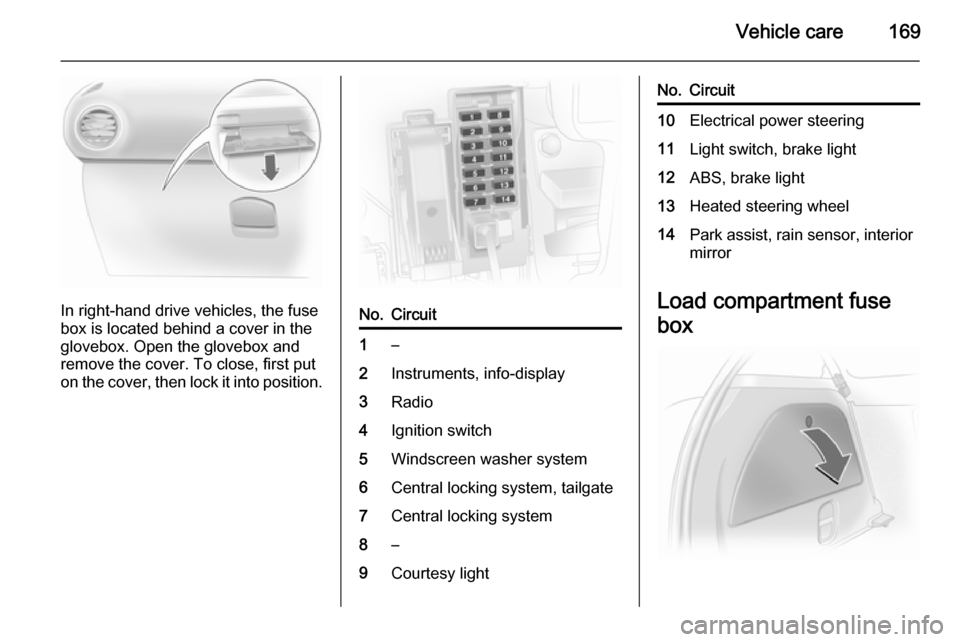
Vehicle care169
In right-hand drive vehicles, the fuse
box is located behind a cover in the
glovebox. Open the glovebox and
remove the cover. To close, first put
on the cover, then lock it into position.
No.Circuit1–2Instruments, info-display3Radio4Ignition switch5Windscreen washer system6Central locking system, tailgate7Central locking system8–9Courtesy lightNo.Circuit10Electrical power steering11Light switch, brake light12ABS, brake light13Heated steering wheel14Park assist, rain sensor, interior mirror
Load compartment fuse
box
Page 172 of 231

170Vehicle care
The fuse box is on the left side of theload compartment behind a cover.
Remove the cover.No.Circuit1Adaptive forward lighting2–3Seat heater (left)4Seat heater (right)5–6–No.Circuit7–8Rear carrier system, towing
equipment9–10–11–12–13–14–15Rear carrier system, towing
equipment16–17SunroofVehicle tools
Tools
To open the compartment, disengagethe cover and open it, or, depending
on the version, lift the floor cover.
Page 173 of 231
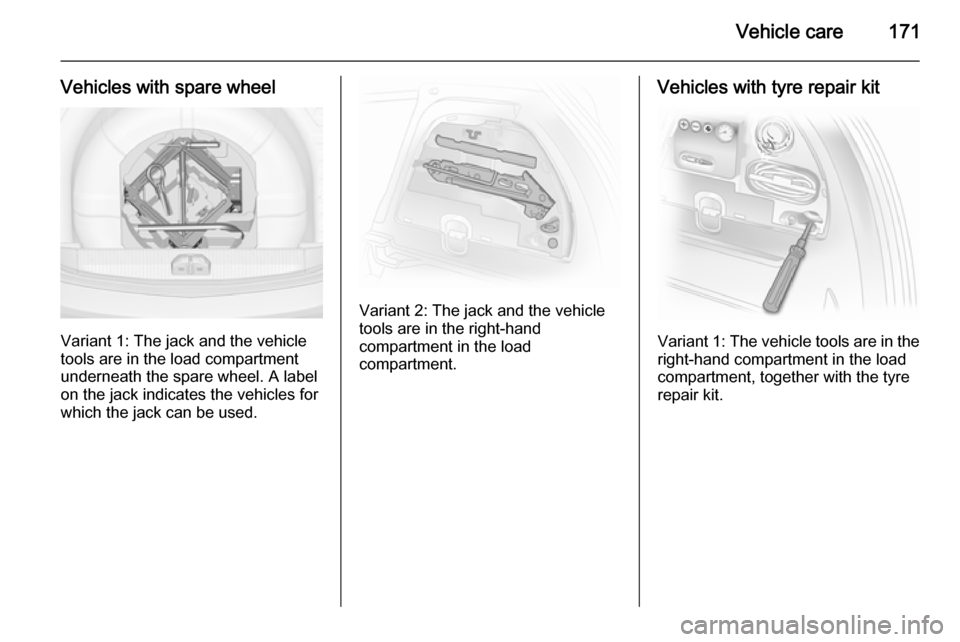
Vehicle care171
Vehicles with spare wheel
Variant 1: The jack and the vehicle
tools are in the load compartment
underneath the spare wheel. A label
on the jack indicates the vehicles for
which the jack can be used.
Variant 2: The jack and the vehicle
tools are in the right-hand
compartment in the load
compartment.
Vehicles with tyre repair kit
Variant 1: The vehicle tools are in the
right-hand compartment in the load
compartment, together with the tyre repair kit.
Page 174 of 231
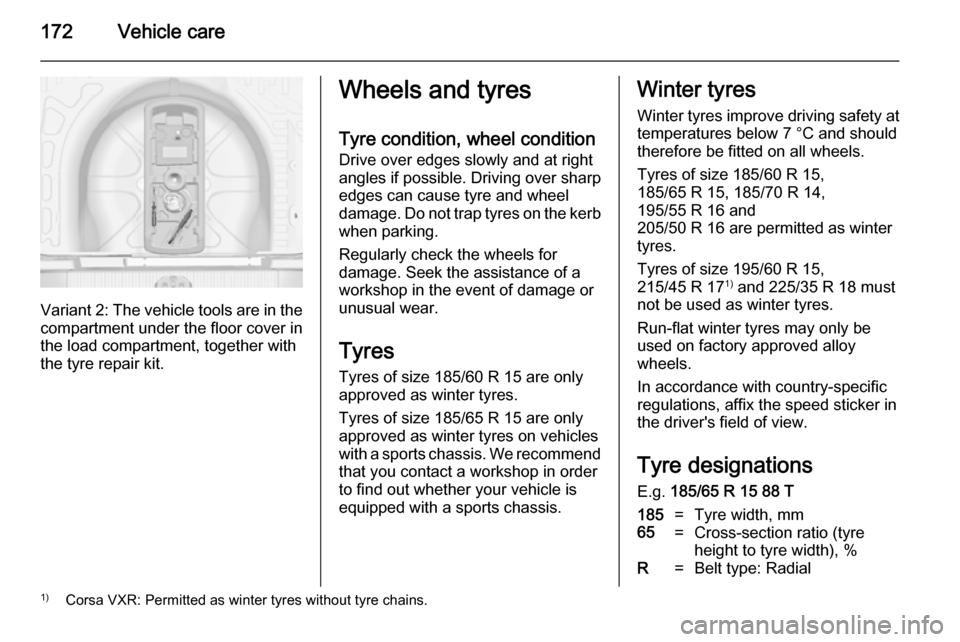
172Vehicle care
Variant 2: The vehicle tools are in the
compartment under the floor cover in
the load compartment, together with
the tyre repair kit.
Wheels and tyres
Tyre condition, wheel condition
Drive over edges slowly and at right
angles if possible. Driving over sharp
edges can cause tyre and wheel
damage. Do not trap tyres on the kerb when parking.
Regularly check the wheels for
damage. Seek the assistance of a
workshop in the event of damage or
unusual wear.
Tyres Tyres of size 185/60 R 15 are only
approved as winter tyres.
Tyres of size 185/65 R 15 are only
approved as winter tyres on vehicles with a sports chassis. We recommend that you contact a workshop in order
to find out whether your vehicle is
equipped with a sports chassis.Winter tyres
Winter tyres improve driving safety attemperatures below 7 °C and should
therefore be fitted on all wheels.
Tyres of size 185/60 R 15,
185/65 R 15, 185/70 R 14,
195/55 R 16 and
205/50 R 16 are permitted as winter
tyres.
Tyres of size 195/60 R 15,
215/45 R 17 1)
and 225/35 R 18 must
not be used as winter tyres.
Run-flat winter tyres may only be
used on factory approved alloy
wheels.
In accordance with country-specific
regulations, affix the speed sticker in
the driver's field of view.
Tyre designationsE.g. 185/65 R 15 88 T185=Tyre width, mm65=Cross-section ratio (tyre
height to tyre width), %R=Belt type: Radial1) Corsa VXR: Permitted as winter tyres without tyre chains.
Page 175 of 231
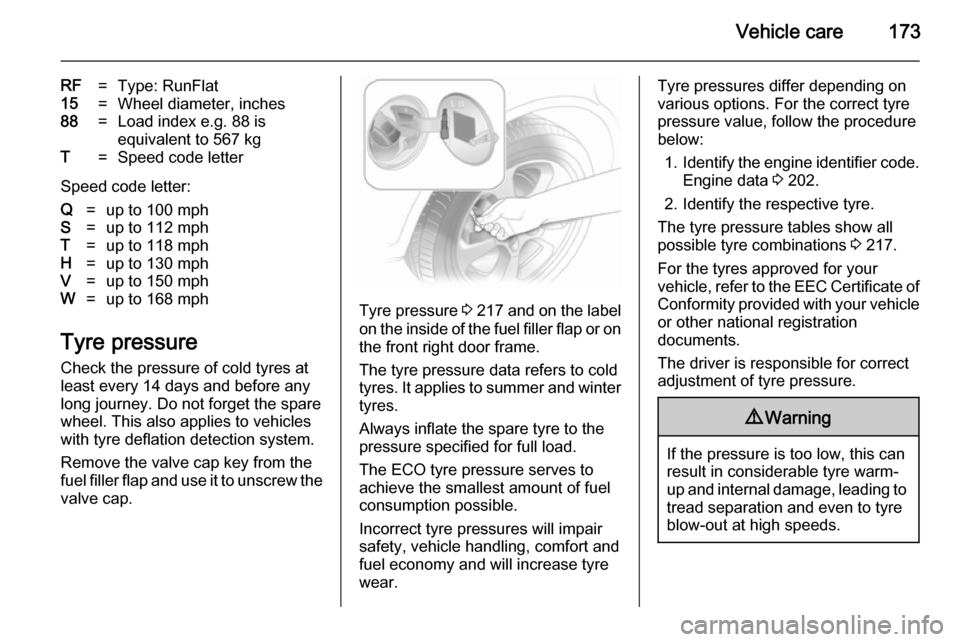
Vehicle care173
RF=Type: RunFlat15=Wheel diameter, inches88=Load index e.g. 88 is
equivalent to 567 kgT=Speed code letter
Speed code letter:
Q=up to 100 mphS=up to 112 mphT=up to 118 mphH=up to 130 mphV=up to 150 mphW=up to 168 mph
Tyre pressure
Check the pressure of cold tyres at
least every 14 days and before any
long journey. Do not forget the spare
wheel. This also applies to vehicles
with tyre deflation detection system.
Remove the valve cap key from the
fuel filler flap and use it to unscrew the valve cap.
Tyre pressure 3 217 and on the label
on the inside of the fuel filler flap or on
the front right door frame.
The tyre pressure data refers to cold
tyres. It applies to summer and winter tyres.
Always inflate the spare tyre to the
pressure specified for full load.
The ECO tyre pressure serves to
achieve the smallest amount of fuel
consumption possible.
Incorrect tyre pressures will impair
safety, vehicle handling, comfort and
fuel economy and will increase tyre
wear.
Tyre pressures differ depending on
various options. For the correct tyre
pressure value, follow the procedure
below:
1. Identify the engine identifier code.
Engine data 3 202.
2. Identify the respective tyre.
The tyre pressure tables show all
possible tyre combinations 3 217.
For the tyres approved for your
vehicle, refer to the EEC Certificate of
Conformity provided with your vehicle
or other national registration
documents.
The driver is responsible for correct
adjustment of tyre pressure.9 Warning
If the pressure is too low, this can
result in considerable tyre warm-
up and internal damage, leading to tread separation and even to tyre
blow-out at high speeds.
Page 176 of 231

174Vehicle careTyre pressure monitoring
system The vehicle may be fitted with a tyrepressure monitoring system or a tyre
deflation detection system 3 175.Caution
Modifications made to the tyre
pressure monitoring system
(TPMS) by anyone other than an
authorised service facility may
void authorisation to use the
system.
The tyre pressure monitoring system
checks the pressure of all four wheels once a minute when vehicle speed
exceeds a certain limit.
Caution
Tyre pressure monitoring system
warns only about low tyre pressure
condition and does not replace
regular tyre maintenance by the
driver.
All wheels must be equipped with pressure sensors and the tyres must
have the prescribed pressure.
Notice
In countries where the tyre pressure
monitoring system is legally
required, the use of wheels without
pressure sensors will invalidate the
vehicle type approval.
Winter tyres or additional wheel sets
have to be fitted with sensors,
otherwise the system will not work
and the control indicator A illuminates
continuously.
If A lights up, stop as soon as
possible and inflate the tyres as
recommended 3 217.
After inflating, driving may be
required to extinguish A.
If A lights up at lower temperatures
and extinguishes after some driving,
this could be an early indicator for getting low pressure. Check tyre
pressure.
The tyre pressure monitoring system
malfunction indicator is combined
with the low tyre pressure controlindicator. If the system detects a
malfunction, the control indicator will
flash for approx. 1 minute and then
remain continuously illuminated. This sequence will continue upon
subsequent vehicle start‐ups as long as the malfunction exists.
A temporary spare wheel is not
equipped with a pressure sensor. The
tyre pressure monitoring system is
not operational for these wheels.
Control indicator A illuminates.
Operating electronic devices or being
near facilities using radio wave
frequencies similar to the tyre
pressure monitoring system could
cause the tyre pressure monitoring
system sensors to malfunction.
Tyre pressure monitoring system malfunctions may occur for a variety
of reasons, including the installation
of replacement or alternate tyres or
wheels on the vehicle that prevent the tyre pressure monitoring system fromfunctioning properly. Always check
the tyre pressure monitoring system
malfunction control indicator after
replacing one or more tyres or wheels
Page 177 of 231

Vehicle care175
on your vehicle to ensure that the
replacement or alternate tyres and wheels allow the tyre pressure
monitoring system to continue to
function properly.
The use of commercially available
liquid tyre repair kits can impair the
function of the system. Factory
approved repair kits can be used.
System initialisation After a wheel change or tyre pressure
adjustment the system must be
initialised: inflate the cold tyres to the
prescribed pressure according to the
tyre information label or this
document 3 217. Then switch on
ignition and press and hold the DDS
button for approx. 4 seconds. The
control indicator A flashes three
times.
If the tyre pressure difference
between the left and the right wheel
on one axle is more than 30 kPa, tyre
pressure monitoring system
malfunction will be indicated, as the
vehicle starts moving for the first time after initialisation. Adjust tyre
pressure and repeat initialisation.Notice
The system needs to be initialised
after tyre pressure change,
otherwise it will not be able to warn
properly.
Each time the tyres are replaced, the
tyre pressure monitoring system
sensors have to be dismounted and
serviced. For the screwed sensor
replace the valve core and sealing
ring, for the clipped sensor replace
complete rubber valve stem.
Auto learn function
After changing wheels the vehicle
must be stationary for approx.
20 minutes, before the system
recalculates. The following relearn
process takes up to 10 minutes of
driving with a minimum speed of
16 mph.
Tyre deflation detection
system The tyre deflation detection system
continually checks the rotation speed
of all four tyres.
If a tyre loses pressure the control
indicator w illuminates red. Stop
immediately and check tyre pressure.
Control indicator w 3 83.
Page 178 of 231
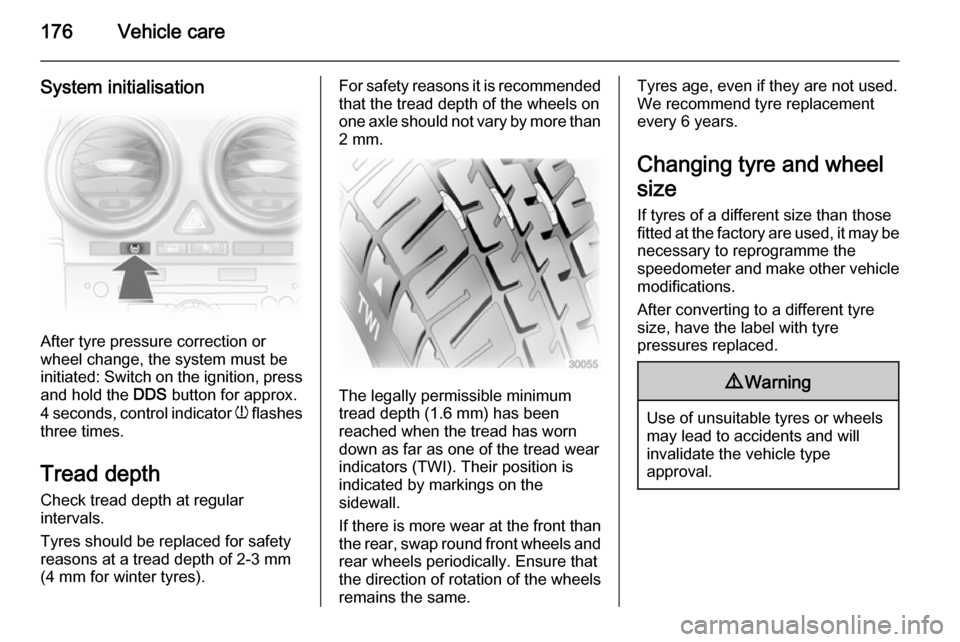
176Vehicle care
System initialisation
After tyre pressure correction or
wheel change, the system must be
initiated: Switch on the ignition, press and hold the DDS button for approx.
4 seconds, control indicator w flashes
three times.
Tread depth
Check tread depth at regular
intervals.
Tyres should be replaced for safety
reasons at a tread depth of 2-3 mm
(4 mm for winter tyres).
For safety reasons it is recommended
that the tread depth of the wheels on
one axle should not vary by more than 2 mm.
The legally permissible minimum
tread depth (1.6 mm) has been
reached when the tread has worn
down as far as one of the tread wear
indicators (TWI). Their position is
indicated by markings on the
sidewall.
If there is more wear at the front than
the rear, swap round front wheels and
rear wheels periodically. Ensure that
the direction of rotation of the wheels
remains the same.
Tyres age, even if they are not used.
We recommend tyre replacement
every 6 years.
Changing tyre and wheel
size If tyres of a different size than those
fitted at the factory are used, it may be necessary to reprogramme the
speedometer and make other vehicle
modifications.
After converting to a different tyre
size, have the label with tyre
pressures replaced.9 Warning
Use of unsuitable tyres or wheels
may lead to accidents and will
invalidate the vehicle type
approval.
Page 179 of 231
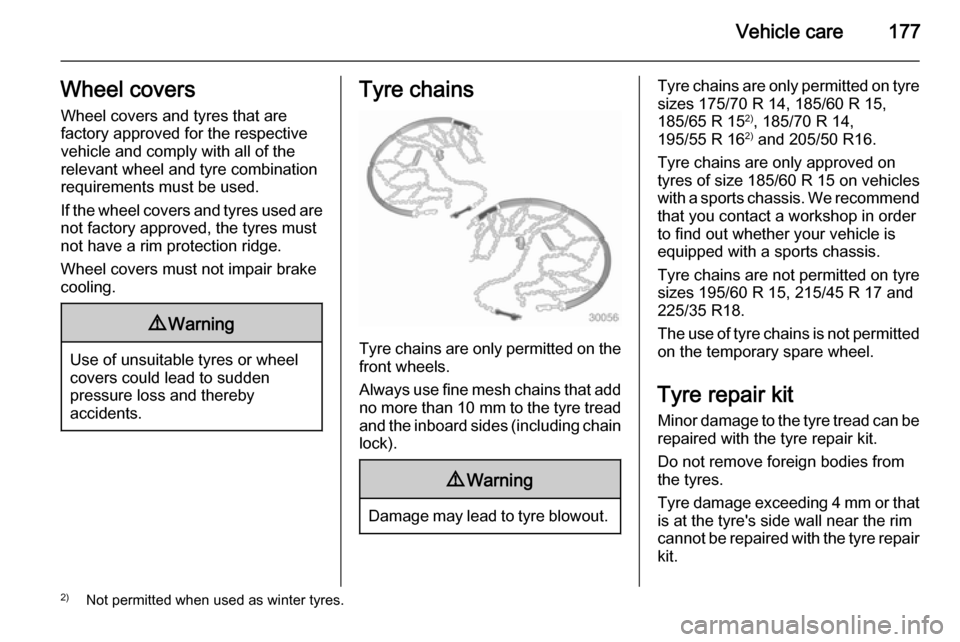
Vehicle care177Wheel coversWheel covers and tyres that are
factory approved for the respective
vehicle and comply with all of the
relevant wheel and tyre combination
requirements must be used.
If the wheel covers and tyres used are
not factory approved, the tyres must
not have a rim protection ridge.
Wheel covers must not impair brake
cooling.9 Warning
Use of unsuitable tyres or wheel
covers could lead to sudden
pressure loss and thereby
accidents.
Tyre chains
Tyre chains are only permitted on the
front wheels.
Always use fine mesh chains that add no more than 10 mm to the tyre tread
and the inboard sides (including chain lock).
9 Warning
Damage may lead to tyre blowout.
Tyre chains are only permitted on tyre
sizes 175/70 R 14, 185/60 R 15,
185/65 R 15 2)
, 185/70 R 14,
195/55 R 16 2)
and 205/50 R16.
Tyre chains are only approved on
tyres of size 185/60 R 15 on vehicles
with a sports chassis. We recommend that you contact a workshop in order
to find out whether your vehicle is
equipped with a sports chassis.
Tyre chains are not permitted on tyre
sizes 195/60 R 15, 215/45 R 17 and
225/35 R18.
The use of tyre chains is not permitted on the temporary spare wheel.
Tyre repair kit Minor damage to the tyre tread can be
repaired with the tyre repair kit.
Do not remove foreign bodies from
the tyres.
Tyre damage exceeding 4 mm or that
is at the tyre's side wall near the rim
cannot be repaired with the tyre repair kit.2) Not permitted when used as winter tyres.
Page 180 of 231

178Vehicle care9Warning
Do not drive faster than 50 mph.
Do not use for a lengthy period.
Steering and handling may be
affected.
If you have a flat tyre:
Apply the parking brake and engage
first gear, reverse gear or P.
The tyre repair kit is stowed in the load
compartment.
Depending on the equipment, the tyre repair kit is in a compartment in the
right sidewall or in a compartment
under the floor cover.
Vehicles with tyre repair kit in
the sidewall
To open the compartment, disengage the cover and open it.
1. Take the sealant bottle and bracket with air hose from the
insert.